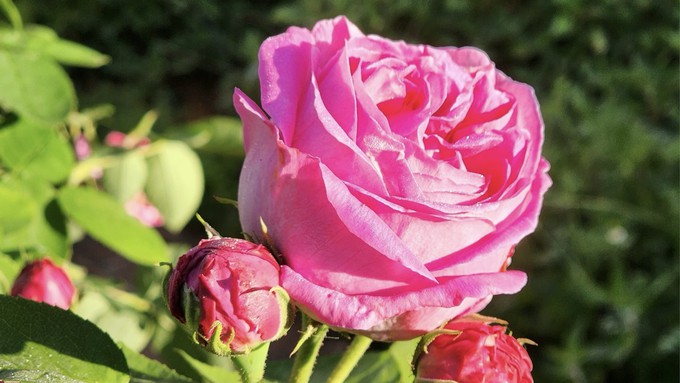
Preservation group propagates rose varieties found, in some cases, nowhere else

Barbara's Pasture Rose is named for the late Barbara Oliva, who discovered it. Photo courtesy Anita Clevenger
These old roses need new homes.
The former volunteers of the Sacramento Historic Rose Garden (formerly at Sacramento's Old City Cemetery) are still trying to preserve rare and historic roses, including varieties found nowhere else. Now, they have dozens of bushes, grown on their own roots and ready for transplanting.
Saturday, June 8, the group is hosting a rose sale at the home of Anita Clevenger, 877 53rd St., Sacramento. From 9 a.m to 2 p.m., shop for roses that you’ll likely not find anywhere else.
“Some varieties are small, such as ‘Serna House,’ a miniature China rose that blooms continuously,” Clevenger says. “Plants are $15 each, first come first served, cash only. We don’t ship.”
Funds raised will go towards rose preservation and … more roses.
“Proceeds cover our expenses and will also be passed along to other heritage rose gardens/groups,” Clevenger says.
Some varieties are in very limited quantities. For the best selection, shop early.
“Most of these (varieties) are listed in Helpmefind.com/roses if you’d like more details,” Clevenger notes.
Each of these roses has a compelling back story to go along with their beauty and fragrance. Among the roses expected to be available:
‘Abbott & Burns’: A miniature China rose brought to California by wagon train in 1857.
‘Adorable Pink Polly’: A cemetery seedling, this grows into a 4-foot arching bush; pink, fragrant and adorable!
‘Arnold’: A rare Rugosa hybrid; large, single, scarlet red.
‘Barbara's Pasture Rose’: Named for heritage rose expert Barbara Oliva, this renowned pink Hybrid Perpetual looks similar to ‘La Reine.’
‘Belle Story’: A newcomer compared to other varieties, this English-style shrub rose was developed by David Austin; its heavy 4-inch blooms are peachy pink.
‘Celsiana’: An old Damask rose dating from 1750, it bears intensely fragrant clusters of light pink blooms in spring.
‘Dora’s Farmhouse Rose’: Discovered in the garden of a Modesto farmhouse, this is a dark pink Hybrid Perpetual, similar to ‘Health Food.’
‘Fiddletown Cherry’: A ‘found’ Tea rose discovered in Amador County, this light pink gem is very fragrant.
‘G. Nabonnand’: With a strong, sweet fragrance, this light apricot Tea rose was named for the 19th century French rose breeder Gilbert Nabonnand who created it.
‘Health Food’: A dark pink Hybrid Perpetual, this charming and carefree rose got its name because it was found “Across From the Health Food Store” in a Sierra foothills town.
‘Oneto Home Saffron’: Discovered by Fred Boutin, this small Tea or China rose stays small – under 3 feet tall – with golden yellow, fragrant blooms fading to creamy white.
‘Over the Fence’: A pink large-flowered climber of unknown parentage, this vigorous rose lives up to its name.
‘Perle d’Or’: Introduced in France in 1883, this fragrant Polyantha bears clusters of little apricot and yellow blooms.
‘Serna House’: A miniature China rose, this dark pink beauty looks very similar to ‘Rouletti’ or a miniature ‘Old Blush.’
For more details and photos: https://www.facebook.com/historicrosegarden.
Comments
0 comments have been posted.Sacramento Digs Gardening to your inbox.
Food in My Back Yard Series
May 6: Maintain soil moisture with mulch for garden success
April 29: What's (already) wrong with my tomato plants?
April 22: Should you stock up on fertilizer? (Yes!)
April 15: Grow culinary herbs in containers
April 8: When to plant summer vegetables
April 1: Don't be fooled by these garden myths
March 25: Fertilizer tips: How to 'feed' your vegetables for healthy growth
March 18: Time to give vegetable seedlings some more space
March 11: Ways to win the fight against weeds
March 4: Potatoes from the garden
Feb. 25: Plant a fruit tree now -- for later
Feb. 18: How to squeeze more food into less space
Feb. 11: When to plant? Consider staggering your transplants
Feb. 4: Starting in seed starting
Sites We Like
Garden Checklist for week of May 11
Make the most of the lower temperatures early in the week. We’ll be back in the 80s by Thursday.
* Plant, plant, plant! It’s prime planting season in the Sacramento area. Time to set out those tomato transplants along with peppers and eggplants. Pinch off any flowers on new transplants to make them concentrate on establishing roots instead of setting premature fruit.
* Direct-seed melons, cucumbers, summer squash, corn, radishes, pumpkins and annual herbs such as basil.
* Harvest cabbage, lettuce, peas and green onions.
* In the flower garden, direct-seed sunflowers, cosmos, salvia, zinnias, marigolds, celosia and asters. (You also can transplant seedlings for many of the same flowers.)
* Plant dahlia tubers.
* Transplant petunias, marigolds and perennial flowers such as astilbe, columbine, coneflowers, coreopsis, dahlias, rudbeckia and verbena.
* Keep an eye out for slugs, snails, earwigs and aphids that want to dine on tender new growth.
* Feed summer bloomers with a balanced fertilizer.
* For continued bloom, cut off spent flowers on roses as well as other flowering plants.
* Add mulch to the garden to maintain moisture. Mulch also cuts down on weeds. But don’t let it mound around the stems or trunks of trees or shrubs. Leave about a 6-inch-to-1-foot circle to avoid crown rot or other problems.
* Remember to weed! Pull those nasties before they set seed.
* Water early in the day and keep seedlings evenly moist.